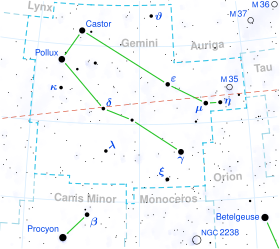81 Geminorum
| Observation data Epoch J2000 Equinox J2000 | |
|---|---|
| Constellation | Gemini |
| Right ascension | 07h 46m 07.45014s[1] |
| Declination | +18° 30′ 36.0217″[1] |
| Apparent magnitude (V) | 4.89[2] |
| Characteristics | |
| Spectral type | K4 III[3] |
| B−V color index | 1.425±0.034[2] |
| Astrometry | |
| Radial velocity (Rv) | +83.13±0.08[2] km/s |
| Proper motion (μ) | RA: −79.687[1] mas/yr Dec.: −53.551[1] mas/yr |
| Parallax (π) | 9.1500 ± 0.2963 mas[1] |
| Distance | 360 ± 10 ly (109 ± 4 pc) |
| Absolute magnitude (MV) | −0.19[2] |
| Orbit[4] | |
| Period (P) | 1,519.7±1.7 d |
| Semi-major axis (a) | ≥ 142±3 Gm |
| Eccentricity (e) | 0.325±0.015 |
| Periastron epoch (T) | 41,584±11 MJD |
| Argument of periastron (ω) (secondary) | 73±3° |
| Semi-amplitude (K1) (primary) | 7.21±0.13 km/s |
| Details | |
| 81 Gem A | |
| Mass | 1.22[5] M☉ |
| Radius | 33.7+2.0 −1.7[1] R☉ |
| Luminosity | 287.3±10.5[1] L☉ |
| Surface gravity (log g) | 1.94[6] cgs |
| Temperature | 4,095+109 −115[1] K |
| Metallicity [Fe/H] | −0.18±0.06[2] dex |
| Age | 6.32[5] Gyr |
| Other designations | |
| Database references | |
| SIMBAD | data |
81 Geminorum is a binary star[8] system in the northern constellation of Gemini. It has the Bayer designation g Geminorum, while 81 Geminorum is its Flamsteed designation. This system is visible to the naked eye as a faint, orange-hued point of light with an apparent visual magnitude of 4.89.[2] The pair are located approximately 360 light years away from the Sun, based on parallax,[1] and are moving further away with a radial velocity of +83 km/s, having come to within an estimated 164 light-years of the Earth nearly a million years ago.[2] 81 Geminorum lies close enough to the ecliptic to undergo lunar occultations.[4][9]
The variable velocity of this system was first suspected at the Dominion Astrophysical Observatory in 1921, then confirmed by the Lick Observatory in 1922. It is a single-lined spectroscopic binary with an orbital period of 4.2 years and an eccentricity of 0.325.[4] The visible component is an aging giant star with a stellar classification of K4 III,[3] having exhausted the supply of hydrogen at its core then expanded to 34[1] times the Sun's radius. It is over six[5] billion years old with 1.22[5] times the mass of the Sun. This is a candidate alpha-enhanced star that displays a significant overabundance of silicon.[10] The star is radiating around 287[1] times the Sun's luminosity from its bloated photosphere at an effective temperature of 4,095 K.[1]
References[edit]
- ^ a b c d e f g h i j k l Brown, A. G. A.; et al. (Gaia collaboration) (August 2018). "Gaia Data Release 2: Summary of the contents and survey properties". Astronomy & Astrophysics. 616. A1. arXiv:1804.09365. Bibcode:2018A&A...616A...1G. doi:10.1051/0004-6361/201833051. Gaia DR2 record for this source at VizieR.
- ^ a b c d e f g Anderson, E.; Francis, Ch. (2012), "XHIP: An extended hipparcos compilation", Astronomy Letters, 38 (5): 331, arXiv:1108.4971, Bibcode:2012AstL...38..331A, doi:10.1134/S1063773712050015, S2CID 119257644.
- ^ a b Keenan, P.; McNeil, R. (October 1989), "The Perkins catalog of revised MK types for the cooler stars", Astrophysical Journal Supplement Series, 71: 245–266, Bibcode:1989ApJS...71..245K, doi:10.1086/191373.
- ^ a b c Griffin, R. F. (September 1982), "Photoelectric radial velocities. Paper IX. The orbits of the spectroscopic binaries 81 and chi Gem", Monthly Notices of the Royal Astronomical Society, 200: 1161–1168, Bibcode:1982MNRAS.200.1161G, doi:10.1093/mnras/200.4.1161.
- ^ a b c d Luck, R. Earle (2015), "Abundances in the Local Region. I. G and K Giants", The Astronomical Journal, 150 (3): 88, arXiv:1507.01466, Bibcode:2015AJ....150...88L, doi:10.1088/0004-6256/150/3/88, S2CID 118505114.
- ^ Prugniel, Ph.; et al. (July 2011), "The atmospheric parameters and spectral interpolator for the MILES stars", Astronomy & Astrophysics, 531: A165, arXiv:1104.4952, Bibcode:2011A&A...531A.165P, doi:10.1051/0004-6361/201116769, S2CID 54940439.
- ^ "81 Gem". SIMBAD. Centre de données astronomiques de Strasbourg. Retrieved 19 August 2017.
- ^ Eggleton, P. P.; Tokovinin, A. A. (September 2008), "A catalogue of multiplicity among bright stellar systems", Monthly Notices of the Royal Astronomical Society, 389 (2): 869–879, arXiv:0806.2878, Bibcode:2008MNRAS.389..869E, doi:10.1111/j.1365-2966.2008.13596.x, S2CID 14878976.
- ^ Cassar, L.; et al. (March 1989), "Lunar Occultations of IRAS Point Sources, 1991--2000", Astrophysical Journal Supplement, 69: 651, Bibcode:1989ApJS...69..651C, doi:10.1086/191323.
- ^ Franchini, M.; et al. (2004). "Synthetic Lick Indices and Detection of α-enhanced Stars. II. F, G, and K Stars in the -1.0 < [Fe/H] < +0.50 Range". The Astrophysical Journal. 613 (1): 312. Bibcode:2004ApJ...613..312F. doi:10.1086/422909. S2CID 250877375.

